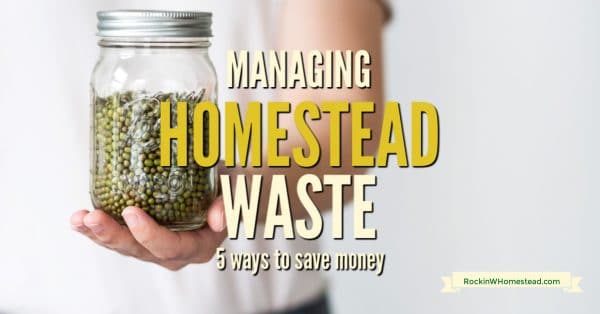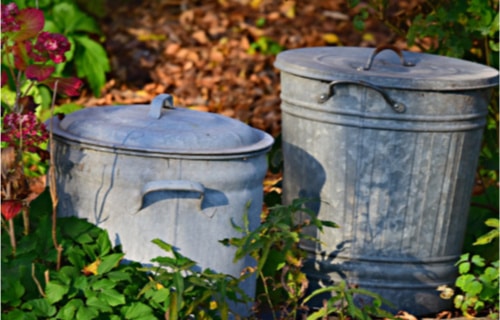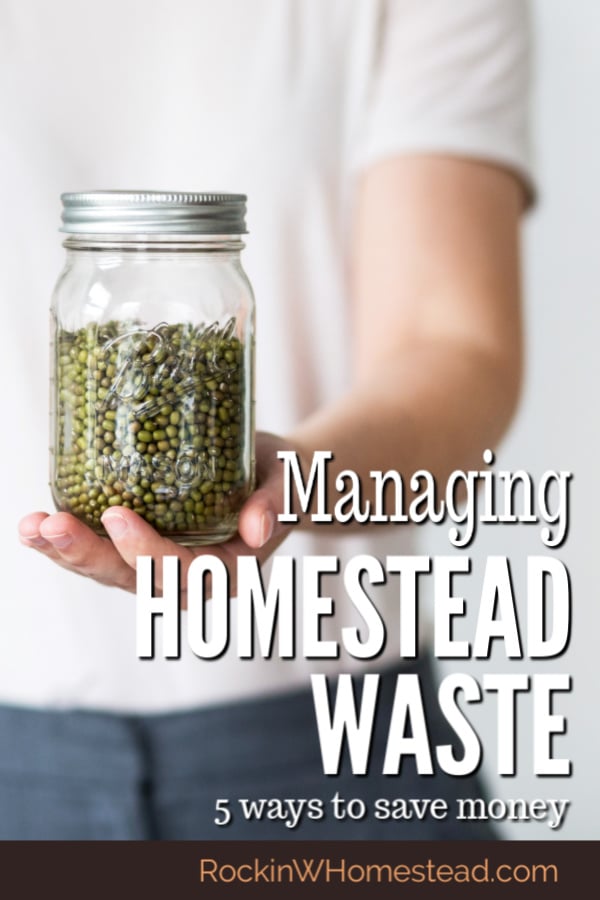Managing homestead waste can be one of the most effective ways to save money. When you take the time to think about what you are bringing on to your property you will naturally reduce, reuse, and recycle.

Years ago we lived on the side of a mountain in the foothills of the Oregon Cascades. It was a beautiful environment with tall pine trees and plenty of green vegetation all around. There was one drawback to this idyllic place. We didn’t have recycling with our garbage service.
I’m not sure why the provider dropped this important concept for those of us in the mountain, after all, they offered it to their customers in town! The only way we could recycle our plastic was to take it into town to the recycling center. That required creating a whole house system for saving, sorting, and carting away our recyclables.
During that year I learn that managing homestead waste saves a lot of money. It also reduces the trips you need to take to the recycling center.
Make Recycling Convenient
Let’s face it, we are more likely to recycle if it’s convenient to do. That requires systems. You’ll want to set up a system that makes it easy and part of your daily routine and one that your family can easily use.
I found that the key to setting up an effective system is to make sure that each tub is clearly marked. If there is any doubt, the family will not self-sort the items and will instead leave them for me. Leave no doubt about what goes into each tub. I just used an old, under the sink garbage can and wrote the recycling rules on it with a black sharpie marker.
If you must sort, do it immediately after you use the article. This will save time later and keeps your kitchen cleaner because it can get messy to have a stack of items that need to be cleaned before they can be added into the recycling container.
For example, we have several containers for trash and recycling available in our current kitchen. You’ll want to have containers for:
- Composting container for countertop or under the sink. Don’t just throw away food scraps, compost them!
- A trash container to disposing of the things that cannot be reused or recycled.
- A recycling area to collect the pieces into an out of the way place so it does not become unsightly. (Speaking from experience, this area can easily get out of hand if you do not organize it!)
Our current trash provider does not require us to sort our recycling, it all goes into one large tub for curbside collection. When you are part of a recycling program, they will generally give you information about what can and cannot be accepted. There are some things that might be accepted, but only under certain conditions.

In our mountain house days, we also had to sort our waste by:
Glass containers, which are by far the easiest item to reuse. I like to use clean glass containers for craft items, for storing leftovers, and for storing herbs and spices. I reuse as many glass containers as I can and the rest go to recycling.
Paper/cardboard: Set up a separate paper collection area to gather these items. I have a tub in my home office and a shredder for sensitive documents and credit card offers that come in the mail. When it’s time to take your items to the recycling center, it won’t take much effort to pack them up and move them out.
You’ll find that plastic containers are what you will have to dispose of the most. All plastic items have recycling numbers on the bottom of their containers. This helps you to know which items can and cannot be recycled. Here’s a look at which numbers are generally accepted:
- 1 and 2 are almost always accepted by recycling programs
- 6, and 7 are generally not accepted
- 4 and 5 are sometimes accepted, but you’ll need to ask the program
For example, plastic water bottles are recyclable but their lids are not. Some programs will take them with the lids, but others require you to do the work of removing them. Make sure to follow the guidelines set up by your trash removal provider.
5 Ways Managing Homestead Waste Saves Money
- Managing your waste makes you think about what you are bringing onto your property. Can you purchase only the amount you need in bulk? This saves on packaging and food waste
- Reuse items whenever possible. Make quilts with old jeans, recycle glass jars, and use plastic in new ways. When you reuse or repurpose you save a new item from being manufactured. One of the greatest threats to the planet’s health is waste and trash. Landfills are getting full and in the United States, trash is often collected and taken by barge to other countries. It’s critical for the health of our planet that we manage how much we are using and throwing away.
- Taking steps to reduce what you buy, reuse what you have, and recycle as many other items as possible is one of the most important things you can do as a citizen of Earth. It may take a lifestyle change, but these practices can become routine.
- Take a break from buying new items. That money can be used to get or stay out of debt, pay for future education expenses, or purchase more environmentally friendly items. Not only can you help to save the planet, but you can also rescue your bank account
- Consider getting rid of items using online lists such as Craigslist. You can give items away for free or even try to make a little money for them. Either way, you’re benefiting the environment by keeping items out of the landfill. You may think that nobody would want some of your old items, but you’d be surprised what someone else may think about your “junk”. The saying, ”one man’s trash is another man’s treasure,” is absolutely true.
Learn more about reducing clutter and your dependence on disposable products. You can find other ways to Sustain Your Homestead by Managing Waste in my companion article on Hello Homestead.

It’s good to know that there are many ways out there that I could reduce the amount of trash I make. I’ll for sure look at implementing some of the tips that you mentioned here. If I can’t recycle certain items, I do know that there are waste removal services that I can go with instead.